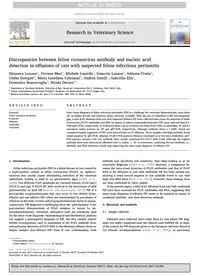
2017 Discrepancies between feline coronavirus antibody and nucleic acid detection in effusions of cats with suspected fe PDF
Preview 2017 Discrepancies between feline coronavirus antibody and nucleic acid detection in effusions of cats with suspected fe
Contents lists available at ScienceDirect Research in Veterinary Science journal homepage: www.elsevier.com/locate/rvsc Discrepancies between feline coronavirus antibody and nucleic acid detection in effusions of cats with suspected feline infectious peritonitis Eleonora Lorussoa, Viviana Maria, Michele Losurdoa, Gianvito Lanavea, Adriana Trottaa, Giulia Dowgiera, Maria Loredana Colaiannib, Andrea Zatellic, Gabriella Eliaa, Domenico Buonavogliaa, Nicola Decaroa,⁎ a Department of Veterinary Medicine, University of Bari, Strada per Casamassima Km 3, Valenzano, Bari 70010, Italy b Istituto Zooprofilattico Sperimentale di Puglia e Basilicata, via Manfredonia 20, 71121 Foggia, Italy c Medical Consultancy Services, 60, Suite 6, G Cali Street, XBX 1424 Ta' Xbiex, Malta A R T I C L E I N F O Keywords: Feline infectious peritonitis Diagnosis Effusions Antibodies Viral RNA A B S T R A C T Intra-vitam diagnosis of feline infectious peritonitis (FIP) is a challenge for veterinary diagnosticians, since there are no highly specific and sensitive assays currently available. With the aim to contribute to fill this diagnostic gap, a total of 61 effusions from cats with suspected effusive FIP were collected intra-vitam for detection of feline coronavirus (FCoV) antibodies and RNA by means of indirect immunofluorescence (IIF) assay and real-time RT- PCR (qRT-PCR), respectively. In 5 effusions there was no evidence for either FCoV RNA or antibodies, 51 and 52 specimens tested positive by IIF and qRT-PCR, respectively, although antibody titres ≥ 1:1600, which are considered highly suggestive of FIP, were detected only in 37 effusions. Three samples with high antibody levels tested negative by qRT-PCR, whereas 18 qRT-PCR positive effusions contained no or low-titre antibodies. qRT- PCR positive samples with low antibody titres mostly contained low FCoV RNA loads, although the highest antibody titres were detected in effusions with CT values > 30. In conclusion, combining the two methods, i.e., antibody and RNA detection would help improving the intra-vitam diagnosis of effusive FIP. 1. Introduction Feline infectious peritonitis (FIP) is a lethal disease of cats caused by a hypervirulent variant of feline coronavirus (FCoV), an alphacor- onavirus that usually causes self-limiting infections of the intestinal epithelium, leading to mild or no gastroenteric signs (Addie et al., 2009). Two different FCoV genotypes are currently known, FCoV type I (FCoV-I) and type II (FCoV-II), both involved in the occurrence of mild gastroenteritis or fatal FIP (Decaro and Buonavoglia, 2011). FIP is a perivascular pyogranulomatosis that may occur in two clinical forms, effusive and non-effusive FIP, which are characterized by prevalence of effusions in the body cavities and of pyogranulomatous lesion in organs, respectively. FIP diagnosis is challenging since the ‘gold standard’ is the post-mortem demonstration of FCoV antigens in tissues by im- munohistochemistry. Therefore, alternative tools are commonly used for the intra-vitam diagnosis. Haematological and biochemical analyses can support a presumptive diagnosis of FIP, but they usually require further investigations, such as assessment of the FCoV antibody titres and molecular detection of FCoV RNA in the effusions (effusive form) or bioptic samples (non-effusive FIP) from ill cats. Unfortunately, both methods lack specificity and sensitivity, thus often leading to an in- conclusive diagnosis (Addie et al., 2009). Recently, a comparison be- tween the intra-vitam detection of FCoV antibodies and that of FCoV RNA in the effusions of cats with confirmed FIP has been carried out, showing a trend toward negative or low antibody levels in cats with high viral RNA titres (Meli et al., 2013). However, these findings have not been confirmed by other studies. In the present paper, a total of 61 effusions from cats with confirmed FIP have been screened for FCoV antibodies and RNA, suggesting that intra-vitam diagnosis of effusive FIP needs to be assessed by means of combined antibody- and virus-detection methods. 2. Materials and methods 2.1. Sample collection Effusions were collected intra-vitam from 61 cats whose FIP diag- nosis was highly suspected since the clinical cases fulfilled all, or most, of the criteria for FIP diagnosis given in the European Advisory Board of Cat Disease recommendations (Addie et al., 2009,), as previously http://dx.doi.org/10.1016/j.rvsc.2017.10.004 Received 14 June 2017; Received in revised form 17 October 2017; Accepted 28 October 2017 ⁎ Corresponding author. E-mail address:
